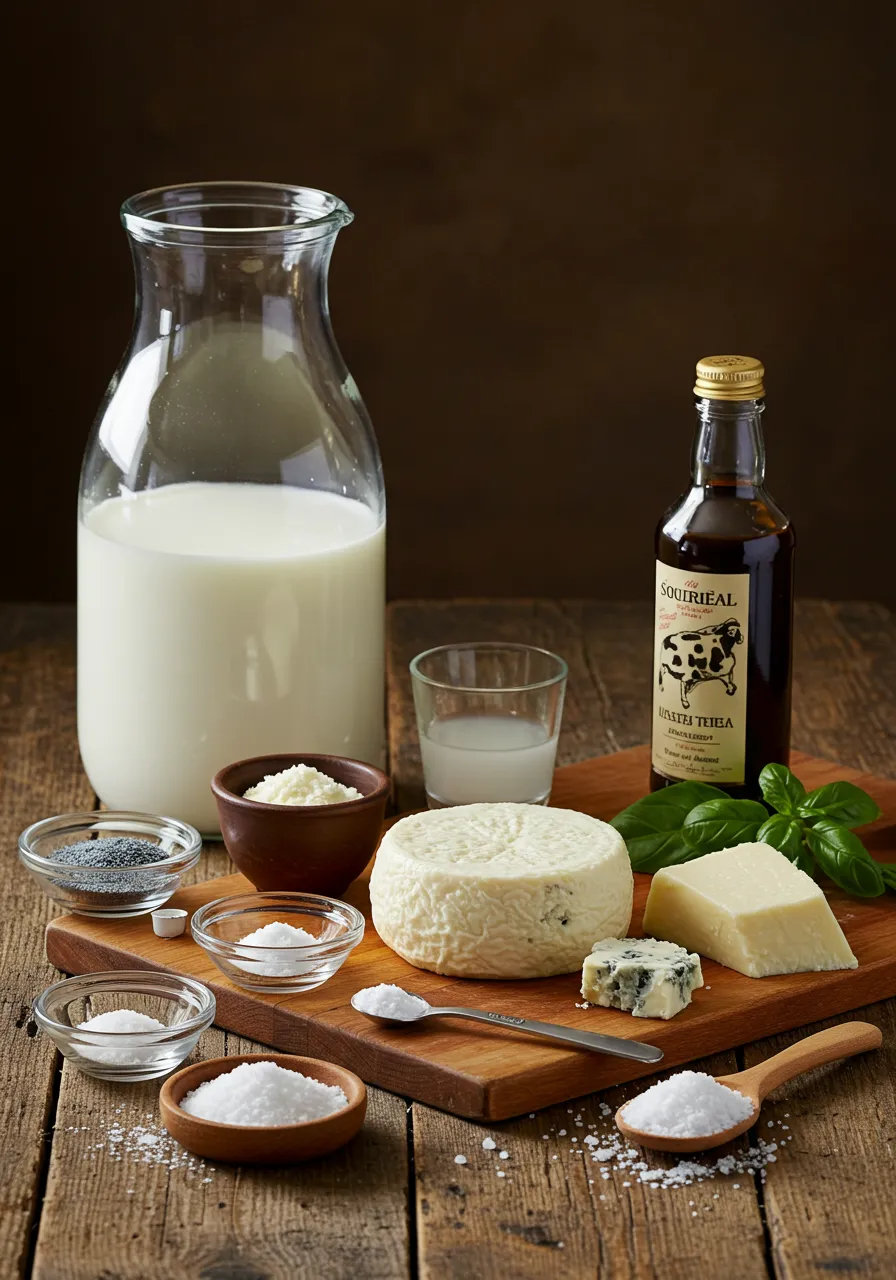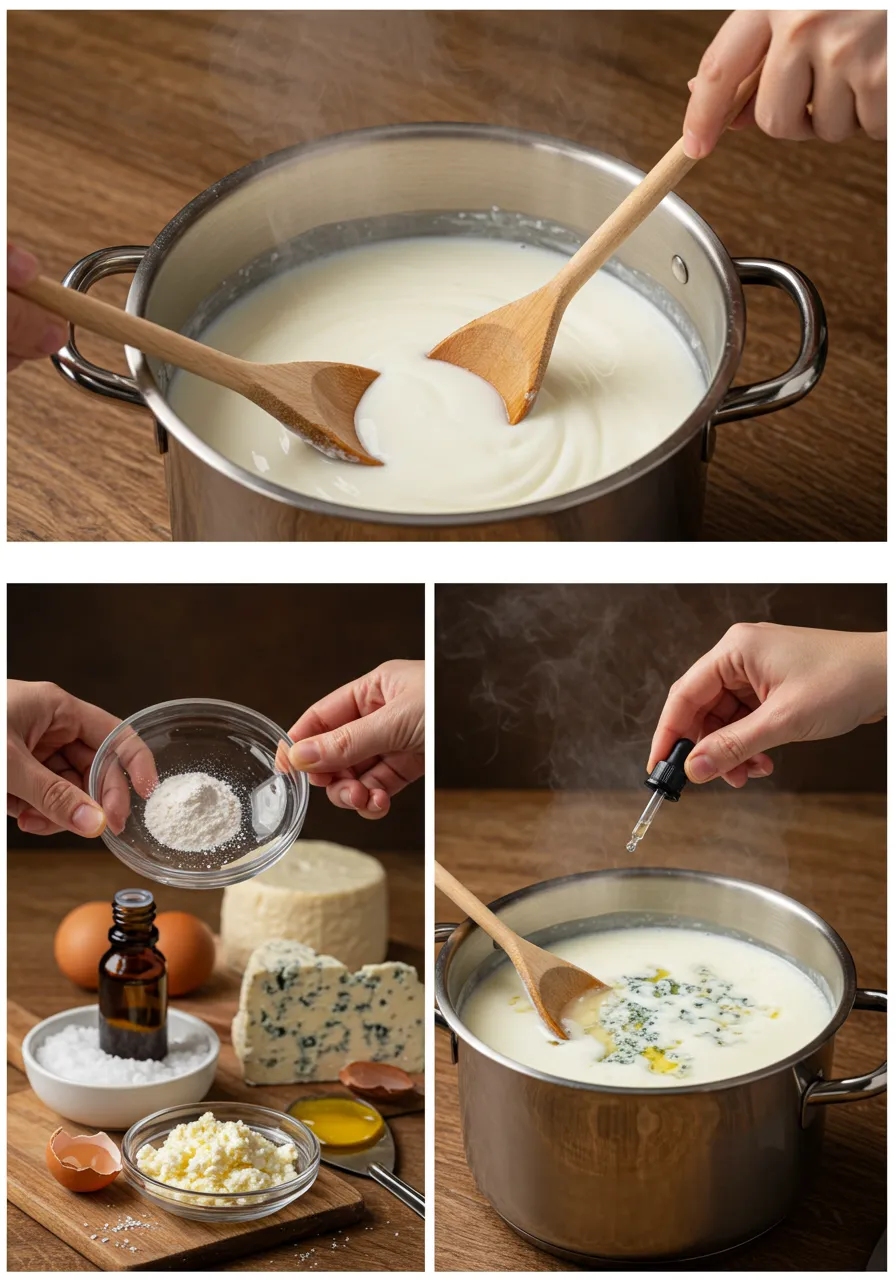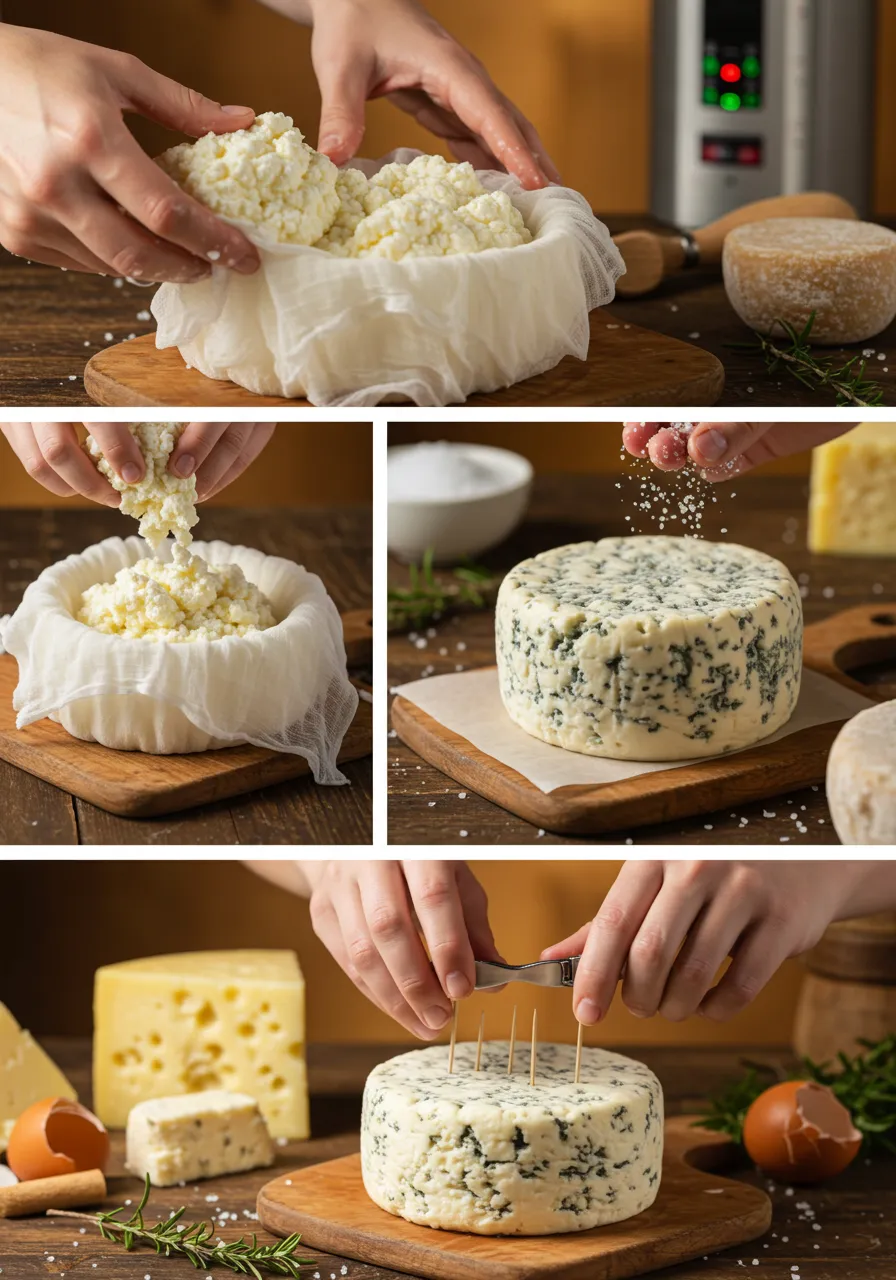Gorgonzola cheese is a masterpiece of Italian craftsmanship, offering a rich, creamy texture with a bold, tangy bite. Whether you prefer the mild, buttery notes of Gorgonzola Dolce or the sharp intensity of Gorgonzola Piccante, this aged cheese brings a touch of luxury to any dish.
Have you ever wondered what makes Gorgonzola so unique? Aged under controlled conditions, this soft-ripened cheese develops its signature blue veining through natural mold cultures. The result is a complex, savory flavor that pairs beautifully with fresh pears, honey, nuts, and even a glass of bold red wine.
Looking to elevate your meals? Gorgonzola melts effortlessly into sauces, adds depth to salads, and transforms simple appetizers into something truly indulgent. In this guide, you’ll learn how to make your own Gorgonzola cheese and discover expert tips on how to enjoy it at its best.
Print
Gorgonzola Cheese The Luxurious Flavor You Need Now
- Total Time: 6 months + 2 hours
- Yield: 2 large wheels (approximately 4 lbs each)
- Diet: Vegetarian
Description
Indulge in the creamy, bold flavors of homemade Gorgonzola cheese, a luxurious Italian blue cheese that enhances any dish. This recipe guides you through the traditional process of making Gorgonzola from scratch, ensuring the perfect balance of creamy texture and tangy, complex flavors. Whether crumbled over salads, melted into sauces, or enjoyed on a gourmet cheese board, this rich and flavorful cheese will elevate your culinary creations.
Ingredients
Essential Ingredients
- 4 gallons whole cow’s milk (preferably raw or pasteurized, non-homogenized)
- 1/4 teaspoon Penicillium Roqueforti mold culture (for blue veining)
- 1/4 teaspoon mesophilic starter culture (to acidify the milk)
- 1/2 teaspoon liquid calcium chloride (if using pasteurized milk, to aid curd formation)
- 1/2 teaspoon liquid rennet (diluted in 1/4 cup non-chlorinated water)
- 1 tablespoon cheese salt (for flavor and moisture control)
Optional Enhancements
- 1/8 teaspoon lipase powder (for a sharper, tangier flavor)
- 1 cup heavy cream (for extra richness and a smoother texture)
Instructions
Step 1: Heat the Milk and Add the Starter Culture
- In a large stainless-steel pot, heat 4 gallons of whole milk over low heat until it reaches 86°F (30°C), stirring occasionally.
- Sprinkle mesophilic starter culture over the surface of the milk and let it sit for 2 minutes before stirring gently.
- Cover the pot and let the milk culture for 30 minutes undisturbed.
Step 2: Introduce the Mold and Rennet
- Sprinkle Penicillium Roqueforti mold culture evenly over the milk and let it dissolve for 2 minutes before stirring.
- If using pasteurized milk, add calcium chloride mixed with a small amount of non-chlorinated water.
- Stir in liquid rennet (diluted in water) using an up-and-down motion to distribute evenly.
- Let the milk sit undisturbed for 60 minutes, allowing a firm curd to form.
Step 3: Cut and Drain the Curds
- Once the curd is set, cut it into 1-inch cubes using a long knife in a grid pattern.
- Let the curds rest for 5 minutes, then stir gently every few minutes for 20 minutes while maintaining the 86°F (30°C) temperature.
- Drain about 30% of the whey, ensuring the curds remain moist for proper aging.
Step 4: Molding and Pressing
- Transfer the curds into a cheese mold lined with cheesecloth.
- Lightly press the curds together, ensuring small air pockets remain for blue mold development.
- Flip the cheese every 12 hours over the next 24 hours to help it hold its shape.
Step 5: Salting and Piercing for Blue Veining
- Sprinkle cheese salt over the surface and let it absorb naturally over two days, flipping the cheese daily.
- Move the cheese to an aging space set at 50-55°F (10-13°C) with 85-90% humidity.
- After four days, use a sterilized skewer to pierce multiple holes throughout the cheese to allow oxygen for mold growth.
Step 6: Aging and Final Touches
- Flip the cheese every two days during the first three weeks to ensure even aging.
- Gorgonzola Dolce is ready in two months, while Gorgonzola Piccante develops its intense flavor over three to six months.
- Once aged to your preference, wrap the cheese in wax paper and store it in the refrigerator.
- Let the cheese rest at room temperature for 30 minutes before serving to bring out its full depth of flavor.
Notes
- Milk Quality Matters: For the best flavor, use raw milk. If using pasteurized milk, always add calcium chloride.
- Piercing Technique: Ensure the cheese is pierced thoroughly, as oxygen is essential for blue veining.
- Storage Tip: Wrap Gorgonzola in wax paper, then loosely cover with foil to maintain freshness.
- Prep Time: 2 hours
- Cook Time: 6 months (aging)
- Category: Cheese Making
- Method: Aged, Fermented
- Cuisine: Italian
If you’re curious about other blue-veined cheeses, check out this comprehensive guide to blue cheese, which covers its history, types, and culinary applications.
Key Benefits of Gorgonzola Cheese
Gorgonzola cheese is more than just a gourmet ingredient—it’s a bold, flavorful addition to any kitchen. Whether you’re a cheese connoisseur or just exploring its tangy taste, this Italian classic offers rich texture, nutritional benefits, and incredible versatility.
1. Creamy Texture with Bold Flavor
Gorgonzola has a unique balance of creamy and crumbly textures. The milder Gorgonzola Dolce is smooth and buttery, while Gorgonzola Piccante is firmer with a sharper bite. This variety lets you choose the perfect intensity for your recipes.
If you enjoy exploring different cheese textures, take a look at everything you need to know about Asiago cheese, another Italian classic with a distinct taste.
2. Packed with Nutrients
As a naturally aged cheese, Gorgonzola is rich in calcium, protein, and essential vitamins. It supports bone health and overall wellness, making it a delicious and nutritious choice for high-quality dairy lovers.
3. Enhances a Variety of Dishes
One of Gorgonzola’s greatest strengths is its versatility in cooking. It melts beautifully into sauces, adds a punch of flavor to salads, and pairs wonderfully with fruits and nuts.
Try it in:
- Pasta and risotto – Adds a creamy, rich depth. Get inspired by these Gorgonzola cheese pasta secrets for mouthwatering recipes.
- Salads and appetizers – A sharp contrast to sweet ingredients.
- Steaks and burgers – A bold topping for grilled meats.
- Pizza and flatbreads – A gourmet upgrade to classic flavors.
If you’re looking for more cheesy indulgence, explore old-fashioned baked macaroni and cheese for a comforting dish.
4. Pairs Well with Wine and Gourmet Ingredients
Gorgonzola pairs beautifully with robust wines like Chianti, Cabernet Sauvignon, or Port. It also complements figs, pears, walnuts, and balsamic reduction, making it a perfect addition to any cheese board.
5. A Staple in Italian Cuisine
With a history of over 1,000 years, Gorgonzola remains a beloved part of Italian culinary tradition. Its signature blue veining comes from Penicillium mold cultures, which give it the complex flavors that make it so unique.
For more cheese-related inspiration, check out the essential guide to Colby Jack cheese and discover how it differs from blue cheeses.
Whether crumbled over a dish, melted into a sauce, or enjoyed on its own, Gorgonzola cheese brings depth, richness, and a touch of indulgence to every bite.
Next, we’ll explore the essential ingredients needed to create this luxurious cheese at home.
Ingredients for Gorgonzola Cheese
Making Gorgonzola cheese at home may sound ambitious, but with the right ingredients and careful attention to detail, you can create a creamy, flavorful cheese that rivals store-bought varieties. Each ingredient plays a crucial role in the aging process, texture, and taste of the final product.

Essential Ingredients
- 4 gallons whole cow’s milk (preferably raw or pasteurized, non-homogenized) – Provides a rich, creamy base.
- 1/4 teaspoon Penicillium Roqueforti mold culture – The key to developing Gorgonzola’s signature blue veining.
- 1/4 teaspoon mesophilic starter culture – Helps acidify the milk and kick-starts fermentation.
- 1/2 teaspoon liquid calcium chloride (if using pasteurized milk) – Restores calcium for proper curd formation.
- 1/2 teaspoon liquid rennet (diluted in 1/4 cup non-chlorinated water) – Coagulates the milk into curds.
- 1 tablespoon cheese salt – Enhances flavor and aids in moisture control during aging.
If you’re interested in experimenting with other cheeses, check out this comprehensive guide to making goat cheese appetizers for creative ideas.
Optional Enhancements
- Lipase powder (1/8 teaspoon) – Boosts the tangy flavor for a sharper Gorgonzola.
- Heavy cream (1 cup) – Adds extra richness for a smoother texture.
Choosing the Right Milk
High-quality milk is the foundation of great cheese. If possible, use raw milk for the best flavor development. If using pasteurized milk, make sure it’s non-homogenized and add calcium chloride to restore its natural curdling properties. Avoid ultra-pasteurized milk, as it won’t form proper curds.
Why Each Ingredient Matters
- Penicillium Roqueforti mold is what gives Gorgonzola its signature blue veins and complex aroma.
- Mesophilic culture ensures the proper acid development, which is essential for both texture and taste.
- Rennet allows the milk to form curds, which are then cut and drained to shape the cheese.
- Salt helps control moisture, enhances taste, and prevents unwanted bacterial growth.
Having the right ingredients is the first step toward crafting authentic Gorgonzola cheese. In the next section, we’ll walk through the step-by-step process to turn these simple elements into a rich, flavorful masterpiece.
Instructions to Prepare Gorgonzola Cheese
Making Gorgonzola cheese at home is a rewarding process that requires patience and precision. Each step plays a crucial role in developing the rich, tangy flavor and creamy texture that make this blue-veined cheese so special.

1. Heat the Milk and Add the Starter Culture
- Pour 4 gallons of whole milk into a large stainless-steel pot.
- Slowly heat the milk to 86°F (30°C) over low heat, stirring occasionally to prevent scorching.
- Sprinkle mesophilic starter culture over the milk’s surface, let it sit for 2 minutes, then stir gently to combine.
- Cover the pot and allow the milk to culture for 30 minutes undisturbed.
2. Introduce the Blue Mold and Rennet
- Add Penicillium Roqueforti mold culture by sprinkling it evenly over the milk’s surface. Let it dissolve for 2 minutes, then stir thoroughly.
- If using calcium chloride (necessary for pasteurized milk), mix it with a small amount of non-chlorinated water before adding it.
- Stir in liquid rennet, diluted in 1/4 cup of non-chlorinated water, using an up-and-down motion to distribute it evenly.
- Let the milk sit undisturbed for 60 minutes until it forms a firm curd.
3. Cut and Drain the Curds
- Check if the curd is set by gently pressing it with a clean finger—it should break cleanly.
- Using a long knife, cut the curds into 1-inch cubes in a grid pattern.
- Allow the curds to rest for 5 minutes to firm up.
- Stir gently every few minutes for 20 minutes, keeping the temperature steady at 86°F (30°C).
- Drain about 30% of the whey, ensuring the curds retain enough moisture for proper aging.

4. Molding and Pressing the Cheese
- Transfer the curds into a cheese mold lined with cheesecloth.
- Gently press the curds together with your hands, shaping the cheese without compacting it too much—small air pockets are essential for the blue mold to develop.
- Flip the cheese every 12 hours over the next 24 hours to help it hold its shape.
5. Salting and Piercing for Blue Veining
- Lightly sprinkle cheese salt over the surface and let it absorb naturally over two days, flipping the cheese daily.
- Move the cheese to a temperature-controlled aging space, set at 50-55°F (10-13°C) with 85-90% humidity.
- After four days, use a sterilized skewer to pierce multiple holes throughout the cheese. This step introduces oxygen, which allows the blue mold to grow inside the cheese.
6. Aging and Flavor Development
- Flip the cheese every two days during the first three weeks to ensure even aging.
- As the cheese matures, the characteristic blue veins will form, and the flavor will develop.
- For a milder cheese, Gorgonzola Dolce is ready in two months.
- If you prefer a stronger, more intense taste, Gorgonzola Piccante should be aged for three to six months.
Final Steps
- Once the cheese reaches your preferred level of aging, wrap it in wax paper and store it in the refrigerator.
- Before serving, let it rest at room temperature for 30 minutes to bring out its full depth of flavor.
With time, patience, and the right conditions, you’ll craft a truly artisanal Gorgonzola cheese. Up next, we’ll explore the best ways to serve and enjoy this luxurious creation.
Serving Suggestions for Gorgonzola Cheese
Now that your homemade Gorgonzola has developed its rich, tangy flavor, it’s time to enjoy it. This versatile cheese can elevate a variety of dishes, from simple appetizers to gourmet entrees. Whether you prefer it crumbled, melted, or served as a centerpiece, here are some of the best ways to savor Gorgonzola.

1. Cheese Boards and Appetizers
Gorgonzola is a natural fit for charcuterie boards, pairing beautifully with both sweet and savory elements. Arrange it with:
- Fresh fruits – Pears, figs, apples, and grapes balance the cheese’s sharpness.
- Nuts – Walnuts and almonds add crunch and complement its creamy texture.
- Honey and jams – A drizzle of honey or fig jam enhances its natural richness.
- Crackers and rustic bread – Perfect for spreading or crumbling.
For more cheese-focused appetizers, check out crafting delicious goat cheese appetizers for more inspiration.
2. Salads and Dressings
Crumble Gorgonzola over fresh greens for an instant flavor boost. It pairs exceptionally well with:
- Arugula or spinach – The peppery bite contrasts beautifully with the creamy cheese.
- Candied pecans and dried cranberries – Adds sweetness and texture.
- Balsamic or honey-mustard vinaigrette – The acidity balances the cheese’s boldness.
For a homemade dressing, whisk together Gorgonzola, olive oil, lemon juice, and a splash of buttermilk for a creamy, tangy topping.
3. Pasta and Risotto
Melt Gorgonzola into sauces to create indulgent, restaurant-quality dishes. Try it in:
- Gorgonzola cream sauce – Perfect for gnocchi, penne, or fettuccine.
- Mushroom risotto – Adds depth and a velvety texture.
- Stuffed pasta – Works beautifully in ravioli fillings with ricotta and spinach.
Looking for a high-protein twist? Try this protein mac and cheese recipe for a healthier yet indulgent alternative.

4. Meats and Grilled Dishes
Gorgonzola’s bold taste makes it an excellent topping for:
- Steaks and burgers – A melted layer adds a rich, tangy bite.
- Grilled chicken – Creates a creamy, flavorful sauce.
- Roasted vegetables – Toss with brussels sprouts, potatoes, or beets for a gourmet touch.
For a creamy pairing, explore port wine cheese spread and perfect pairings.
5. Pizza and Flatbreads
Swap traditional mozzarella for crumbled Gorgonzola on pizza or flatbreads. It pairs well with:
- Caramelized onions and prosciutto – A balance of sweet and salty.
- Pear slices and arugula – A sophisticated twist on classic flavors.
- Truffle oil drizzle – Elevates the earthy, umami taste.
6. Wine and Beverage Pairings
The complex flavor of Gorgonzola shines when paired with the right drink. Try it with:
- Bold red wines – Cabernet Sauvignon, Merlot, or Chianti complement its intensity.
- Sweet dessert wines – Port and Sauternes contrast beautifully with its saltiness.
- Craft beers – Aged stouts or hoppy IPAs enhance its richness.
Bringing It All Together
Gorgonzola is more than just a cheese—it’s a versatile ingredient that transforms everyday meals into something extraordinary. Whether you enjoy it simply on a cracker or melted into a gourmet dish, its luxurious flavor always makes an impression.
Now that you know the best ways to serve it, let’s explore some frequently asked questions to help you get the most out of your homemade Gorgonzola.
The Unique Flavor and Benefits of Gorgonzola Cheese
- Gorgonzola cheese is a renowned Italian blue cheese, distinguished by its rich, creamy texture and bold, tangy flavor, making it a staple in gourmet cuisine (BBC Good Food).
- This cheese undergoes a precise aging process, during which Penicillium mold cultures create its signature blue veins, enhancing both its taste and texture (Serious Eats).
- Beyond its culinary appeal, Gorgonzola is also a source of essential nutrients like calcium and healthy fats, contributing to strong bones and overall well-being (Harvard T.H. Chan School of Public Health).
FAQs About Gorgonzola Cheese
Gorgonzola cheese is a unique and flavorful ingredient, but if you’re new to working with it, you may have some questions. Below are the most commonly asked questions to help you store, serve, and enjoy this delicious cheese with confidence.
1. How Should I Store Gorgonzola Cheese?
To maintain freshness and prevent it from drying out, follow these storage tips:
- Wrap it in wax paper or parchment paper first, then loosely cover it with aluminum foil. This allows the cheese to breathe while preventing excessive moisture buildup.
- Store it in the cheese drawer or a dedicated section of your refrigerator, ideally at 40-45°F (4-7°C).
- Avoid sealing it in plastic wrap, as this can trap moisture and alter its flavor.
If the cheese starts to dry out, lightly wrap it in a damp paper towel for a few hours before rewrapping it properly.
2. How Long Does Gorgonzola Cheese Last?
- When stored properly, Gorgonzola Dolce (milder, creamier variety) lasts about 2-3 weeks in the fridge.
- Gorgonzola Piccante (firmer and aged longer) can last 4-5 weeks due to its lower moisture content.
- If you see slight surface mold that wasn’t originally part of the blue veining, simply trim off the affected area—the rest of the cheese is still safe to eat.
3. What Are the Best Ways to Melt Gorgonzola?
Gorgonzola melts beautifully when handled correctly. To achieve a smooth, creamy consistency:
- Use low heat to avoid separation. High heat can cause the fats to break apart.
- Stir in a splash of heavy cream or butter to help create a silky sauce.
- If adding to pasta or risotto, mix it in at the final stage of cooking, just before serving.
4. What Should I Do If Gorgonzola Smells Strong?
Gorgonzola naturally has a pungent aroma due to its aging process and blue mold cultures. However, if it smells overly ammonia-like or sour, it may be past its prime. Fresh Gorgonzola should have an earthy, slightly tangy scent but never an overpowering, unpleasant odor.
5. Can People with Lactose Intolerance Eat Gorgonzola?
Yes! Aged cheeses like Gorgonzola have very low lactose levels because most of the lactose is broken down during the aging process. Many people with lactose intolerance can enjoy Gorgonzola without issues, but it’s always best to start with small amounts and see how your body reacts.
6. What Dishes Pair Best with Gorgonzola?
Gorgonzola’s bold, creamy flavor works well in a variety of dishes:
- Pasta dishes – Melt into creamy sauces or use as a filling for stuffed pasta.
- Meats – Crumble over steaks, burgers, or grilled chicken.
- Salads – Toss into arugula, spinach, or mixed green salads with nuts and fruit.
- Flatbreads & pizza – Pair with caramelized onions, pears, or prosciutto.
- Cheese boards – Serve with honey, walnuts, figs, and a glass of red wine.


Love Gorgonzola! Its bold flavor is unmatched. Great read!
nice recipe… i will make it this weeekend
Verry good, i love cheese!